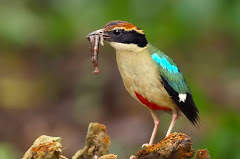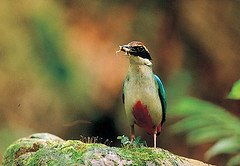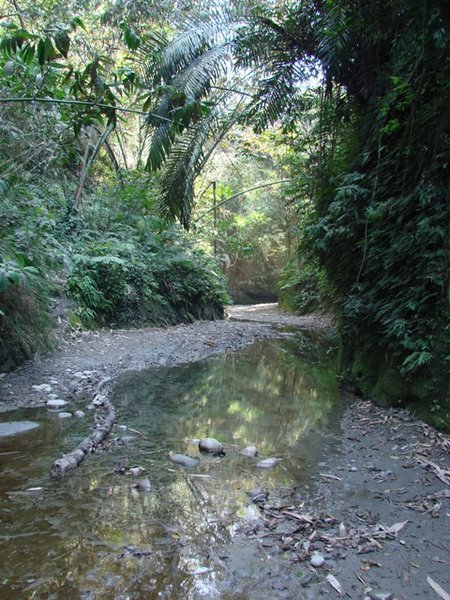The Fairy Temple
“Your Local Patch,” I looked at the heading again. It got me thinking. I had never really thought of having a local patch. Did I have one? Well, I do more birding around the Tian-sheng Gong Temple in Huben than any other place around, so it must be my local patch, and now that I think of it, I really like the idea.
This afternoon at 3:30 I headed out of the small town where I live to my LOCAL PATCH. It takes 15 minutes to get there. I parked my red scooter in the temple grounds, looked up and scanned the sky. I looked and looked, they weren't there. Looking for the resident pair of Crested Serpent Eagle is kind of a "starting to bird now” ritual before I head off into the forest. If I see them soaring above, I feel good and think the birding is going to be good. Well no eagles!
I get into the forest and it's quiet, too quiet. The forest is quiet sometimes. I’ve noticed that it can be very noisy and then silence. When this happens, I’ve often seen one of the small raptors put in an appearance a few moments later. I guess everyone kind of disappears when a Besra or Crested Goshawk is seen looking for a meal.
Well the silence went on for quite sometime, and I didn't see any raptors. When there are no birds around, the low altitude forests of Taiwan can be very uncomfortable places. I think the name low altitude forest is a name that they put in field guides because they don't want to scare birders. The truth is these low altitude forests are a 35 degree in the shade jungle with about a 100% humidity factor and full of starving mosquitoes.
I walked up and up, I was cursing and puffing. All I had seen by the time I got to the top of the hill was a Black Bulbul, a few Chinese Bulbul, and two Grey-cheeked Fulvetta. I turned around and started to walk back down.
I must have been about a third of the way down when I heard it....it was a Fairy Pitta. Now, the area is famous for Fairy Pitta, but I still get blown away every time I see one. Instantly I was transported from the state of birding in the *@#* mosquito jungle to the Utopian state of looking for forest Fairies in low altitude forest. The Pitta was close. I could hear by the call. I stopped to listen and look. The calling stopped. I didn't move. I listen....and wait for the calling to start. I'm standing next to a tree. A moment later there's a movement and the Pitta lands not more than 3metres from me. It has no idea that I'm there. It hops from perch to perch. It must have spent two to three minutes hopping about in front of me before moving off, and so ended the best sighting I've ever had of Taiwan's Forest Fairy.
Also see: Fairy Pitta Gallery
Mr.Chang and the Shamas.
I'm walking along one of the many little forest tracks around the temple and as I round a corner I run into Mr.Chang. Mr.Chang is the local birding guide. He was a hunter for most of his life, but when the area became famous for Fairy Pitta and some other birds he was able to reform himself into a Birding Guide. Now, he's the Pitta's most faithful protector. Meeting up with Mr.Chang if he is out checking on the well being of his Fairies is a wonderful stroke of luck, because you get invited to come along.
After about 30 minutes, as we are watching a Malayan Night Heron, I hear a strange call which I don't recognize. Mr.Chang imitates the call and the bird calls back. Off we go in the direction of the call. We stop and Mr.Chang points to a bird in a tree. The light is not that good, but I know that I've never seen this bird before. I see another movement and it appears that there is a second bird partly obscured by foliage perched near by. There are not that many birds in Taiwan with very long tails. I know I'm not looking at a Treepie or a Paradise Flycatcher. I can see a clear white patch on the rump. I get a good look at the bird, and then turn to Mr.Chang. I take out my field guide and Mr.Chang laughs and says it's not in there. I ask what it is and he says he doesn't know, but the pair lives there. I look again and realize that the bird I'm looking at appears to be a White-rumped Shama (which isn't found in Taiwan).
I head back home and have a good look at pictures of White-rumped Shama and conclude that it is indeed the bird in question. I know that the White-rumped Shama is a popular cage bird in China. I guess that this pair must be escapees that have established themselves in the area. Escaped and released cage birds can be a big problem in Taiwan. These birds can displace resident species and in some cases interbreed with them creating hybrids or if they are of the same species, but a different race, they can dilute the genetic purity of the local endemic race. This has been a major factor in the decline of the Taiwan Hwamei.
The Silver Ghost
Before dawn I was in Huben. It was still very dark and there was a chill in the air as I turned into the yard of Mr. Chang's traditional Taiwanese house. Multitudes of dogs snarled and yapped. They didn't seem too happy to see me. A large roster came over. He seemed friendlier. It was almost as if he was coming over for a predawn chat before doing his morning duty and waking the neighbourhood. Mr. Chang came out and we headed off up the track following the river. We both bounced around on our motorcycles as we headed for his little wooden cabin further up the valley. Today we had a purpose. We were after the very elusive Silver Ghost of Taiwan's forests.
We reached the cabin and parked the motorcycles. We loaded up and climbed down onto the rocks in the river. To go deep into the Huben forest one has to follow the course of a river or stream. The steep cliffs and thick vegetation make it impossible to get deep into the remote parts of the forest other than by this means.
Streams in Huben are very rocky. Generally, they don't carry very much water but when it rains they become raging torrents. It was still dark as we started on our way. We hadn't gone far when the predawn calling of an endemic Taiwan Partridge started. Mr. Chang responded and the partridge called back. It wasn't too far off but the thick forest shielded it from view. We carried on and dawn began to break. The calls of songbirds surrounded us but it was too dark to see anything.
High in the trees above us a Crested Serpent Eagle greeted the new day with a call. Mr. Chang smiled and called back. The eagle immediately responded. We carried on with the soft calls of the eagle floating to us on the breeze every so often.
It was hard going. Despite the chill in the air I was beginning to build up quite a sweat. Mr. Chang indicated we were getting close. Even the slightest rustle of clothing is enough to startle the Ghost. We moved very quietly. We carefully stepped from rock to rock. The forest was light enough to see a fair distance ahead now. We moved forward slowly. We would stop to listen and scan the area ahead for movement. Mr. Chang's sharp ears caught something. I hadn't heard it but he said he had. The Ghost was near.
We moved on. The river narrowed and vegetation had taken root in the stream bed. We stopped and searched the shadows ahead. One second I was looking at a shadow and the next instant the Ghost stepped forward from out of the shadow. We had seen the Ghost at the same instant. We just smiled and nodded. There it was, the distinct silver-white back, crest and tail contrasted with a dazzling blue of the body and the fire-red head and legs. I started to shake with excitement. I could hear my heart drumming in my ears. The Ghost melted into the vegetation and disappeared. I stood there breathless. There really wasn't enough light for a shot but I took my camera out of its bag and moved forward.
I crept over boulders and moved towards where the Ghost had vanished. I crept forward and once again it stepped out of the shadows. It was very dark but I took a few shots just to capture the moment. In an almost dream-like state I watched the Silver Ghost moving about in front of me.
Robert Swinhoe had discovered the species, which is endemic to Taiwan, in April of 1862. Gould had described the species in the 1863 edition of The Ibis. Even the stuffy Victorian, Gould, was impressed by Formosa's Silver Ghost and stated, "This exceedingly beautiful species is one of the most remarkable novelties I have had the good fortune to describe." Gould had described many species from around the world. He named the species after Swinhoe, Lophura swinhoii. When this majestic species was first revealed to the West, many dubbed the newly described Swinhoe's Pheasant as the world's most beautiful bird. To some, it still is.
The pheasant moved off slowly. It was unaware of my presence and I was able to watch it for about two minutes in all. All too quickly time passed and it melted back into the forest. Mr. Chang and I pressed on. I was euphoric. This was my first Huben male. The Swinhoe's Pheasant is considered a bird of the mid elevation mountain forests. The handful that inhabit the lowland hills of Huben indicate that the species probably did inhabit the lowlands before man turned much of the lush lowland forest into fields and paddies.
We moved on and then retraced our steps hoping to get another view of the pheasant. No luck, so we pressed on again. Just as we came to a steep rise Mr. Chang’s sharp ears had heard something. We stopped and waited. Moments later I heard it too. There were Ghosts in the undergrowth. We waited. Suddenly Mr. Chang pointed. I didn't see anything and then my eyes caught a movement. There was a pair. I watched them moving through the undergrowth and then they vanished. It was time to go back.
We walked back down the stream. Monarchs, Fulvettas, and Bulbuls moved about through the trees. Some Spot-breasted Scimitar Babblers started to call. The Crested Serpent Eagle was calling, too. I was soaking the tranquility up and savoring it.
At Mr. Chang's cabin we made some Oolong tea and relaxed. We talked about Huben and its birds. I mentioned the Malayan Night Heron and Mr. Chang imitated the call. From just outside the window there was an immediate response. We both laughed.
It was time to go and I climbed on my motorcycle. I had only gone a few meters when the Malayan Night Heron flew across the road. I stopped and snapped a quick shot of it in the sun. It had been a very special morning.
A Good Saturday's Afternoon
I arrived at the bridge leading into Huben village at about 2:30 and was greeted by the calling of the young Crested Serpent Eagle I had seen on Monday. I have seen a young eagle in this area quite a few times over the past two months so it looks as if it's established a territory in this area. I pulled over and watched it circling overhead for a few minutes before caring on.
Just before arriving at the temple I spotted another Crested Serpent Eagle sitting in a dead tree across the valley. I stopped and watched it for a few minutes. It was a majestic looking mature Eagle. Its crest fluttered in the breeze like plumes on a knight's helmet. I snapped a few long distance shots and moved on.
I parked my motorcycle under the big Bayan tree at the temple and headed off down the track. The usual Light-vented Bulbuls, Spotted Doves, Eurasian Tree Sparrows, Pacific Swallows, and Striated Swallows had all quickly put in an appearance when the calls of a Bronzed Drongo stopped me. As I watched the Bronzed Drongos the calls of some Dusky Fulvettas and Streak-breasted Scimitar Babblers alerted me to their presence. It wasn't long before some Rufous-capped Babblers were putting on a show just off to my right. Shortly they were joined by the Dusky Fulvettas and Streak-breasted Scimitar Babblers.
I moved on and was treated to a view of a dazzling Black-naped Monarch. Some Grey-cheeked Fulvetta started calling just out of view. The sharp almost hiss like alarm call showed that they were well aware of my presence. I spotted a single Japanese White-eye fly overhead and land in the top of some bamboo I was standing near. Moments later a flock of about fifteen joined it.
I arrived at a field planted with orange trees. Light-vented Bulbuls and Collared Finchbills were darting between the trees. There were a great number of these birds amongst the trees. Moments later I spotted a pair of Black Bulbul with there blood red bills and legs offset against there jet black plumage. Then something else caught my eye. It disappeared off amongst the trees. I never got a second look but it was a thrush of shorts for sure, probably a Pale Thrush or Dusky Thrush. Moments later I heard the distinct chi-up notes of the call of a Plain Prinia. I searched the scrub near the path and it wasn't long before I had located it. I looked up and the sky was filled with House Swifts.
I moved on and spotted my third Crested Serpent Eagle for the afternoon flying out of a tree across the valley. I then noticed a flock of about fifteen doves in a dead tree across the valley near to where I had seen the eagle. Something about the doves looked odd. They didn't appear to be the usual Spotted Doves or Red Collared Doves that are very common in Huben. I glassed them and to my joy they were Oriental Turtle Doves. This was a first for my Huben list. Oriental Turtle Doves are quite common in the North of Taiwan but down in the central areas they are uncommon to even pretty rare in some places.
It was getting on and I needed to get back. I had a good walk back to the temple and the second eagle was still sitting in the dead tree across the valley. I started off on my motorcycle and just as I was leaving Huben I had fine views of the brilliant green of a Black-browed Barbet. In Mandarin it is called Wu-se Niao or Bird of Five Colours. A great way to end the day.
Also see:
Taiwan birding stories continued: A Brief History of Grey-Faced Buzzard Conservation in Taiwan
Birding in the Huben-Hushan Area
Birding in Taiwan and Yunlin County
Hushan Bird List
Threatened Birds of the Huben-Hushan area
Fairy Pitta Gallery
Taiwan Bird Books
Thursday, June 21, 2007
Huben Birding Stories
Posted by
Wild at Heart Legal Defense Association
at
11:30 AM
![]()
Subscribe to:
Post Comments (Atom)










No comments:
Post a Comment